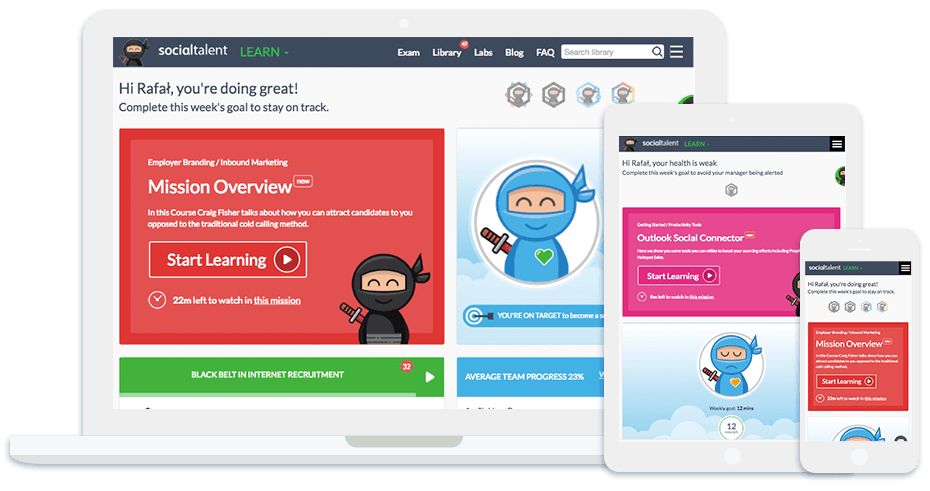Keep up with the latest hiring trends!

If you’re an avid reader of this here blog, you’ll know that we sure do love to talk about job ads. And really, it isn’t any wonder; if your job ads don’t sing, how can you honestly expect to get candidates excited about coming to work at your company?
But what if you’re a recruiter in a corporate, straight-laced organisation? What if creating a fun, behind-the-scenes video, or an ad that’s chock-full of puns and slang is simply out of the question? Is it actually possible to jazz up your job ads when your company is used to doing things a certain way and isn’t too fond of change? You’ll be happy to learn that the answer is yes…but in order to successfully do this, you first need to get over these four stumbling blocks…
Stumbling Block #1: The HR Department

The problem: How can we put this in the nicest possible way…sometimes people in the HR department treat job ads as though they are job descriptions. And that’s ok. Let’s not forget that someone that is high up on the ladder in Human Resources generally has a lot on their plate, from administration to employee relations to training. Writing compelling job ads isn’t really something that they necessarily have time for (or, to be frank, really care about). It’s your job as a recruiter to sell the job, and there’s one very easy way that you can do this, without irking the HR department.
How to get around it: Easy…get rid of the bullet points! A job ad is supposed to summarise the most important duties of the position and sell the opportunity to potential candidates. When there are ten bullet points, all of the information starts to look the same. Plus, by listing everything in bullet points, it looks like the ad has been written by a robot. So turn those bullet points into actual sentences. Rather than having:
- Responsible for implementing new campaigns across social media channels.
try this instead…
‘You will be looking after dreaming up and managing cutting-edge campaigns to run on Facebook and Twitter’
Another tip is to talk about what the person will be doing when they get the job, not if they get the job. Do not, under any circumstances talk about ‘the ideal candidate’ in your ads, because (spoiler alert) they don’t exist! Stick to terms like ‘you, your and yours’ so that potential candidates feel as though you’re speaking to them directly. This doesn’t require much creativity, you’re simply taking half-composed sentences and completing them.
Stumbling Block #2: The Marketing Department

The problem: A lot of marketing departments have templates set up for recruiters so that all they have to do is slot-in all of the information and wham, bam, thank you ma’am! That way it’s formatted, it’s in line with the company branding and it’s done and dusted. Sounds easy, and it is easy…but that’s also what the problem is because you don’t want your job ad to look exactly like all of the thousands of others that are circulating online!
How to get around it: Remember, even if you’re in a heavily corporate environment, your job ad still needs to speak to the persona of the candidate that you want to engage with. Talk to the marketing department about the possibility of changing around the format of the template, or even about the likelihood of scrapping the template (with all due respect) and trying something different, like getting rid of bullet-points or playing around with various headings. If they aren’t convinced, suggest split-testing the ad so that two different versions are published online. Before long, they will see which one performs better and from there you should have concrete evidence to show what format candidates engage with more.
Stumbling Block #3: The Legal Department

The problem: The legal department can be quite rigid in terms of wanting to have information about being an equal opportunities employer in the job ad, as well as not allowing you to reference salaries because there could be other employees in the organisation working in the same role, so listing this could open up a big can of worms for them. However, it’s still possible to make reference to salary to spark interest in candidates without mentioning an actual figure.
How to get around it: Try using the needs/supply fit method in your ads – it’s not enough to talk about all of the duties that the person will be responsible for if they get the job, you need to clearly tell candidates what they will get in return for all of their hard work. They need to know that there’s something in it for them. So instead of having zero mention of salary because it’s a touchy subject, try something along these lines…
‘Salary is dependent on experience, but we offer some of the most competitive salaries in the industry. Not only that, when you work with us you’ll get a shiny new iPhone 6, fully paid health insurance, company laptop and 25 holidays (not to mention a token day off for your birthday!)’
A research paper titled by Joseph A. Schmidt on how language affects application rates found that where job ads were very demand-centric (i.e. saying you’ll be doing this but getting nothing in return), people still applied to those jobs, but overall, quality of candidates was low. However when ads were more needs/supply fit (i.e. we need this and in return we’ll give you this, this and this) there was a three-times spike in application volume and quality. So even people that hadn’t planned on applying for a job felt that they couldn’t pass up this potential opportunity!
Stumbling Block #4: The ATS System

The problem: A lot of the ATS systems out there are hugely inflexible. They are generally built in a certain template where you put in the company blurb, requirements, education, qualifications etc, so there isn’t much opportunity to stand out. Another issue is that when the ATS pushes your ads out to job boards, it often strips them of images, videos, contact details etc.
How to get around it: There are a couple of new ATS systems on the market now that allow you to create custom landing pages for different job types, so if you’re advertising digital marketing jobs you can have related content about digital marketing hanging on the side of the ad itself. Look into these types of systems and talk to the person that looks after the ATS software in the company about the possibility of switching over. If it’s a straight up ‘No’, try to apply all of the above tips around language into your current ATS system. Again, all that you really need to do is remember to speak directly to the candidate when you’re filling out all of the different fields, and that in itself will make a difference.
So, really there’s no excuse for any recruiter to claim that they can’t jazz up their job ads because the culture in their organisation is ‘too corporate’. There are plenty of things that you can do to make little changes that make a big impact. Getting past the four blockers won’t be a piece of cake, but can absolutely be done. Remember, all you have to do is start with one ad. From there, you can let the results lead the way!
Do you want to get more practical tips and advice on writing job ads, as well as how to search for the best candidates using social media? Start your free Internet Recruitment trial with Social Talent today!
(This blog originally appeared on this site in 2016 and has been updated to reflect relevant changes)
Related Articles
Find out how the likes of IBM, IKEA and Siemens
drive hiring excellence with SocialTalent
drive hiring excellence with SocialTalent


